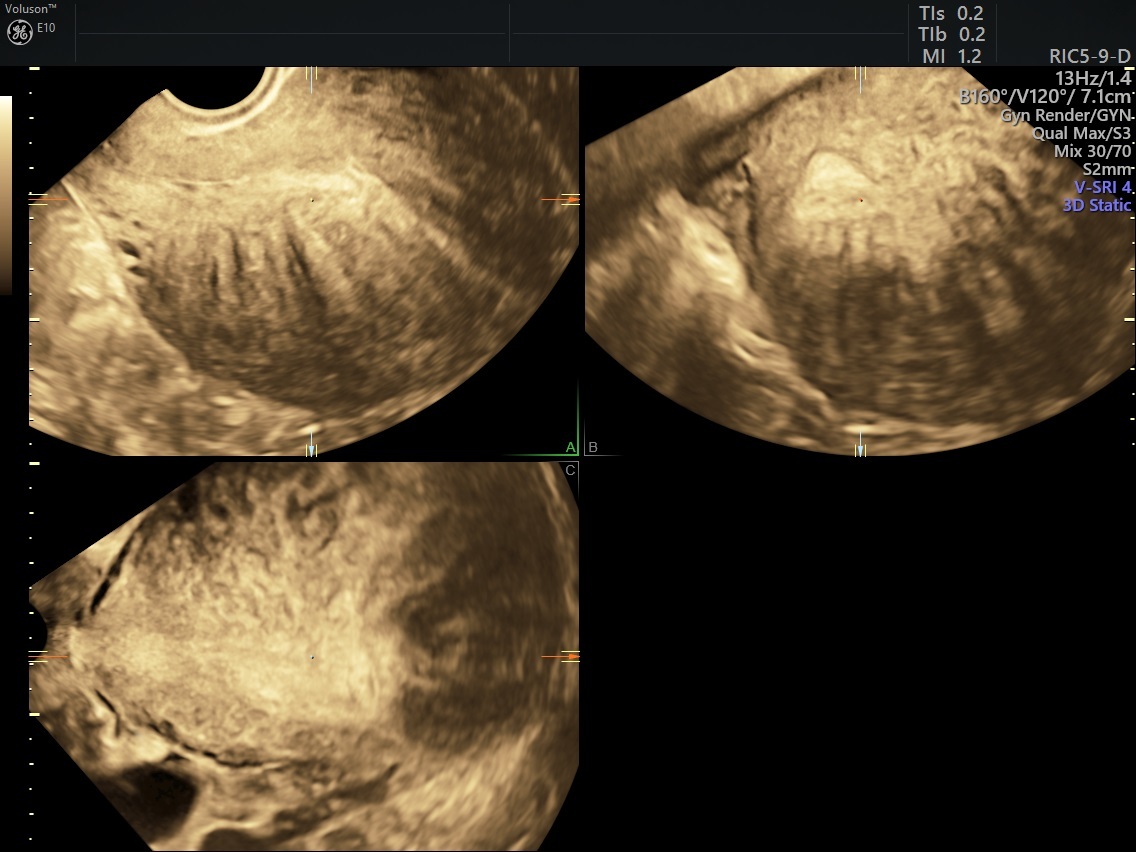Adenomyosis is a condition in which endometrial tissue breaks through and grows into the myometrium; the tissue continues to act the same, which can cause heavy periods and severe dysmenorrhea. Besides causing symptoms that disrupt daily life, this condition can affect a patient's ability to get pregnant. Women with adenomyosis may be infertile, while those experiencing adenomyosis and pregnancy together may have an increased likelihood of miscarriage.
Although adenomyosis most commonly affects women in their 40s and 50s and those who have already had children, about 20 percent of cases appear in women under age 40, according to a study published in Obstetrical and Gynecological Survey. As more people put off parenthood until their late 30s and 40s, doctors are seeing more women with adenomyosis and infertility undergoing in vitro fertilization (IVF).
The condition is also linked to obesity, but even when controlling for age and body weight, women facing adenomyosis and pregnancy have higher rates of miscarriage in both natural and IVF pregnancies. Research is beginning to shed some light on the connection.
Understanding Adenomyosis and Pregnancy
Adenomyosis can make it harder for patients to get pregnant and can lead to more complications during a pregnancy. Research published in Minerva Ginecologica found that women with adenomyosis have an increased likelihood of miscarriage, preterm birth, preterm rupture of membranes, small gestational age and hypertensive disorders. However, it's difficult to form a causal link directly to adenomyosis, and the pool of studies on this matter is relatively small.
Although researchers aren't exactly sure what causes adenomyosis or how it affects fertility, research published in Acta Obstetricia et Gynecologica Scandinavica has theorized that distortion and enlargement of the uterus — a frequent hallmark of adenomyosis — interferes with sperm and oocyte transport. A thickened junctional zone, meanwhile, may impede embryo implantation.
Due to these factors, IVF may not be a viable solution for patients with adenomyosis considering its lower rates of embryo implantation and higher rates of early pregnancy loss.
Linking Adenomyosis and Miscarriage
Whether they conceive naturally or through IVF, patients with adenomyosis tend to have higher rates of miscarriage early on and into the second trimester. Several small studies note this connection, but there are a few confounding factors to consider.
Patients with adenomyosis are likely to have conceived at an advanced maternal age, be obese or have endometriosis, all of which increase the odds of having a miscarriage. Connecting a problem to adenomyosis alone is difficult, but studies that have attempted to control for other known pregnancy risk factors have still found adenomyosis to be associated with poorer pregnancy outcomes.
One study published in Human Reproduction Open suggests that abnormal uterine contractions may contribute to higher miscarriage rates among patients with adenomyosis who are undergoing IVF. Embryo implantation is most successful when the uterus is in a quiescent state during the luteal phase. Women with adenomyosis tend to experience hyper-peristaltic uterine contractions, making implantation more difficult.
Another theory from the study is that the condition causes changes to the uterine environment that can be toxic to embryos. Women with adenomyosis tend to have more macrophage and natural killer cells and an increase in inflammatory mediators.
Research published in Fertility and Sterility suggests that miscarriages or difficulty with implantation may be more likely because of increased prostaglandin levels in the endometrial epithelium and altered levels or functioning of proteins, enzymes and genes in the uterus.
The outlook isn't all negative, however. Patients who receive an early diagnosis and treatment before undergoing IVF or trying to conceive may see better pregnancy outcomes. Both the Human Reproduction and Fertility and Sterility studies found higher pregnancy rates and lower miscarriage rates when patients took a long-term GnRH agonist.
Surgical treatment is sometimes considered, but is not always effective for treating adenomyosis because the margins of invading tissue tend to be diffuse or indistinct.
Diagnosing Adenomyosis
Given the tendency of adenomyosis to be persistent and progressive, timely diagnosis is essential. Evaluating patients for adenomyosis before starting IVF, particularly those who have had multiple miscarriages, helps set patients up for the best possible outcomes. Patients with adenomyosis seeking to get pregnant will need additional management and care to monitor the possibility of complications and preterm birth.
In the past, histopathologic examination was the definitive way to diagnose adenomyosis, but transvaginal 3D ultrasound is now considered the standard diagnostic tool. Color Doppler may add additional detail and help rule out other conditions. For example, Doppler can help a clinician differentiate between the translesional blood vessel pattern of adenomyosis and the circular flow that indicates myoma.
Adenomyosis can occur anywhere in the uterus, but is most often seen in the posterior wall. An ultrasound exam should thoroughly inspect all areas of the uterus. While the terminology and diagnostic criteria used to identify adenomyosis were previously non-standardized, the Morphological Uterus Sonographic Assessment (MUSA) group published a consensus statement in 2015 that now serves as a critical guide to "terms, definitions and measurements" for examining the myometrium via sonography. According to MUSA, signs to look for on ultrasound include:
- Heterogeneous and hypoechogenic areas in the myometrium.
- Fan-shaped shadowing.
- Asymmetrical myometrium.
- Myometrial cysts.
- A thickened junctional zone.

Certain ultrasound markers for adenomyosis may also indicate a higher risk for miscarriage. Women with a diffusely enlarged uterus or a junctional zone abnormality may have a higher miscarriage rate, according to a study published in Obstetrical and Gynecological Survey.
With a detailed ultrasound evaluation and measurements of the junctional zone and uterine enlargement, you can formulate an adenomyosis treatment approach with all the facts in hand. Having this information before beginning IVF will allow you to inform your patient about any miscarriage risks as well as recommend any necessary treatment before they begin trying to conceive.







